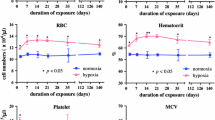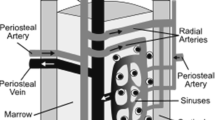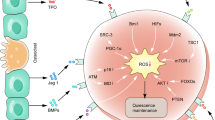Abstract
Background
Erythropoietin supports the survival of erythroblasts. We previously demonstrated that 24 malignant human cell lines expressed erythropoietin and its receptor and that erythropoietin secretion was enhanced under anoxia. In this study, we examined the viability of 22 of these cell lines excluding two leukemia cell lines under anoxia.
Methods
Twenty-two cancer cell lines of various origins were cultured under anoxia or normoxia for 4 days, and their viability was examined at 1-day intervals. The levels of lactate and ATP were measured. The expressions of hypoxia-inducible transcription factor 1α (HIF-1α) and Bcl-2 family proteins were examined by western blotting analysis. The cellular and mitochondrial features were examined by microscopy.
Results
Eleven of the 22 cancer cell lines examined showed 80% to 100% cell viability after 4 days under anoxia; 2 cell lines showed similar viability for 3 days, 3 cell lines showed similar viability for 2 days, and 6 cell lines showed similar viability for 1 day or less. These 11 death-resistant cell lines, which secrete various amounts of erythropoietin under anoxia, produced significantly more lactate during 2 days under anoxia than under normoxia, with ATP levels about 60% of those before anoxia. ATP returned to the normal level when normoxia was restored after 4 days of anoxia. However, the nonresistant cell lines responded to anoxia by yielding significantly more lactate without a reduction of the ATP level. The expression patterns of Bcl-2 family proteins revealed that apoptosis-inhibiting signals predominated over proapoptotic signals in the death-resistant cells under anoxia.
Conclusion
The majority of the cancer cell lines examined survived under anoxia in vitro, through the Pasteur effect, in a dormant state without direct support of erythropoietin.
Similar content being viewed by others
References
GL Semenza (1998) ArticleTitleHypoxia-inducible factor 1 and the molecular physiology of oxygen homeostasis J Lab Clin Med 131 207–214 Occurrence Handle9523843 Occurrence Handle10.1016/S0022-2143(98)90091-9 Occurrence Handle1:CAS:528:DyaK1cXisFGrtbo%3D
LE Huang Z Arany DM Livingston et al. (1996) ArticleTitleActivation of hypoxia-inducible transcription factor depends primarily upon redox-sensitive stabilization of its α subunit J Biol Chem 271 32253–32259 Occurrence Handle8943284 Occurrence Handle10.1074/jbc.271.50.32253 Occurrence Handle1:CAS:528:DyaK2sXit1ehsA%3D%3D
CW Pugh JF O'Rourke M Nagao et al. (1997) ArticleTitleActivation of hypoxia-inducible factor-1; definition of regulatory domains within the α subunit J Biol Chem 272 11205–11214 Occurrence Handle9111021 Occurrence Handle10.1074/jbc.272.2.984 Occurrence Handle1:CAS:528:DyaK2sXjtVamtL4%3D
HF Bunn RO Poyton (1996) ArticleTitleOxygen sensing and molecular adaptation to hypoxia Physiol Rev 76 839–885 Occurrence Handle8757790 Occurrence Handle1:CAS:528:DyaK28XltVags70%3D
S Salceda J Caro (1997) ArticleTitleHypoxia inducible factor 1α (HIF-1α) protein is rapidly degraded by the ubiquitin-proteasome system under normoxic conditions. Its stabilization by hypoxia depends on redox-induced changes J Biol Chem 272 22642–22647 Occurrence Handle9278421 Occurrence Handle10.1074/jbc.272.36.22642 Occurrence Handle1:CAS:528:DyaK2sXlvFGitLk%3D
GL Semenza MK Nejfelt SM Chi et al. (1991) ArticleTitleHypoxia-inducible nuclear factors bind to an enhancer element located 3′ to the human erythropoietin gene Proc Natl Acad Sci USA 88 5680–5684 Occurrence Handle2062846 Occurrence Handle10.1073/pnas.88.13.5680 Occurrence Handle1:CAS:528:DyaK3MXlsFWku7w%3D
I Beck S Ramirez R Weinmann et al. (1991) ArticleTitleEnhancer element at the 3′-flanking region controls transcriptional response to hypoxia in the human erythropoietin gene J Biol Chem 266 15563–15566 Occurrence Handle1874713 Occurrence Handle1:CAS:528:DyaK3MXmt1Ghsrg%3D
A Minchenko S Salceda T Bauer et al. (1994) ArticleTitleHypoxia regulatory elements of the human vascular endothelial growth factor gene Cell Mol Biol Res 40 35–39 Occurrence Handle7528597 Occurrence Handle1:CAS:528:DyaK2cXmslart7s%3D
NV Iyer LE Kotch F Agani et al. (1998) ArticleTitleCellular and developmental control of O2 homeostasis by hypoxia-inducible factor 1α Genes Dev 12 149–162 Occurrence Handle9436976 Occurrence Handle1:CAS:528:DyaK1cXnsVOqsQ%3D%3D
G Helmlinger F Yuan M Dellian et al. (1997) ArticleTitleInterstitial pH and pO2 gradients in solid tumors in vivo: high-resolution measurements reveal a lack of correlation Nat Med 3 177–182 Occurrence Handle9018236 Occurrence Handle10.1038/nm0297-177 Occurrence Handle1:CAS:528:DyaK2sXpsVOktw%3D%3D
LV Dang GL Semenza (1999) ArticleTitleOncogenic alterations of metabolism Trends Biochem Sci 24 68–72 Occurrence Handle10098401 Occurrence Handle10.1016/S0968-0004(98)01344-9 Occurrence Handle1:CAS:528:DyaK1MXltFCgsr4%3D
BH Jiang GL Semenza C Bauer et al. (1996) ArticleTitleHypoxia-inducible factor 1 levels vary exponentially over a physiologically relevant range of O2 tension Am J Physiol Cell Physiol 271 C1172–C1180 Occurrence Handle1:CAS:528:DyaK28XmsF2nurw%3D
C Schroedl DS McClintock GR Budinger et al. (2002) ArticleTitleHypoxic but not anoxic stabilization of HIF-1α requires mitochondrial reactive oxygen species Am J Physiol Lung Cell Mol Physiol 283 L922–L931 Occurrence Handle12376345 Occurrence Handle1:CAS:528:DC%2BD38XovVOltb4%3D
TN Seagroves HE Ryan H Lu et al. (2001) ArticleTitleTranscription factor HIF-1 is a necessary mediator of the Pasteur effect in mammalian cells Mol Cell Biol 21 3436–3444 Occurrence Handle11313469 Occurrence Handle10.1128/MCB.21.10.3436-3444.2001 Occurrence Handle1:CAS:528:DC%2BD3MXjtF2jsb0%3D
PH Maxwell GU Dachs JM Gleadle et al. (1997) ArticleTitleHypoxia inducible factor-1 modulates gene expression in solid tumors and influences both angiogenesis and tumor growth Proc Natl Acad Sci USA 94 8104–8109 Occurrence Handle9223322 Occurrence Handle10.1073/pnas.94.15.8104 Occurrence Handle1:CAS:528:DyaK2sXksl2ktLg%3D
P Carmeliet Y Dor JM Herbert et al. (1998) ArticleTitleRole of HIF-α in hypoxia-mediated apoptosis, cell proliferation and tumor angiogenesis Nature 394 485–490 Occurrence Handle9697772 Occurrence Handle10.1038/28867 Occurrence Handle1:CAS:528:DyaK1cXltVGqsbg%3D
HE Ryan M Poloni W McNulty et al. (2000) ArticleTitleHypoxia-inducible factor-1α is a positive factor in solid tumor growth Cancer Res 60 4010–4015 Occurrence Handle10945599 Occurrence Handle1:CAS:528:DC%2BD3cXlvFOksb8%3D
TG Graeber C Osmanian T Jacks et al. (1996) ArticleTitleHypoxia-mediated selection of cells with diminished apoptotic potential in solid tumours Nature 379 88–91 Occurrence Handle8538748 Occurrence Handle10.1038/379088a0 Occurrence Handle1:CAS:528:DyaK28XivVKgug%3D%3D
GT Williams CA Smith (1993) ArticleTitleMolecular regulation of apoptosis: genetic controls on cell death Cell 74 777–779 Occurrence Handle8104100 Occurrence Handle10.1016/0092-8674(93)90457-2 Occurrence Handle1:CAS:528:DyaK3sXmsVKgtL4%3D
JC Read (1994) ArticleTitleBcl-2 and the regulation of programmed cell death J Cell Biol 124 1–6 Occurrence Handle10.1083/jcb.124.1.1
AH Wyllie (1995) ArticleTitleThe genetic regulation of apoptosis Curr Opin Genet Dev 5 97–104 Occurrence Handle7749333 Occurrence Handle10.1016/S0959-437X(95)90060-8 Occurrence Handle1:CAS:528:DyaK2MXjvFegsbk%3D
JC Martinou DR Green (2001) ArticleTitleBreaking the mitochondrial barrier Nature Rev Mol Cell Biol 2 63–67 Occurrence Handle10.1038/35048069 Occurrence Handle1:CAS:528:DC%2BD3MXivVWmsL4%3D
S Desagher JC Martinou (2000) ArticleTitleMitochondria as the central control point of apoptosis Trends Cell Biol 10 369–377 Occurrence Handle10932094 Occurrence Handle10.1016/S0962-8924(00)01803-1 Occurrence Handle1:CAS:528:DC%2BD3cXls1CktLk%3D
D Perez E White (2000) ArticleTitleTNF-α signals apoptosis through a bid-dependent conformational change in Bax that is inhibited by E1B 19K Molecular Cell 6 53–63 Occurrence Handle10949027 Occurrence Handle10.1016/S1097-2765(00)00007-1 Occurrence Handle1:CAS:528:DC%2BD3cXls1Kls70%3D
Y Yasuda Y Fujita T Matsuo et al. (2003) ArticleTitleErythropoietin regulates tumour growth of human malignancies Carcinogenesis 24 1021–1029 Occurrence Handle12807756 Occurrence Handle10.1093/carcin/bgg060 Occurrence Handle1:CAS:528:DC%2BD3sXkvVSms78%3D
JP Kaltenbach MH Kaltenbach WB Lyons (1958) ArticleTitleNigrosin as a dye for differentiating live and dead ascites cells Exp Cell Res 15 112–117 Occurrence Handle13574164 Occurrence Handle10.1016/0014-4827(58)90067-3 Occurrence Handle1:STN:280:CyaD3czkvFI%3D
M Koritzinsky MG Magagnin T van den Beucken et al. (2006) ArticleTitleGene expression during acute and prolonged hypoxia is regulated by distinct mechanisms of translational control EMBO J 25 1114–1125 Occurrence Handle16467844 Occurrence Handle10.1038/sj.emboj.7600998 Occurrence Handle1:CAS:528:DC%2BD28XitVyisr4%3D
ZN Oltvai CL Milliman SJ Korsmeyer (1993) ArticleTitleBcl-2 heterodimerizes in vivo with a conserved homolog, Bax, that accelerates programmed cell death Cell 74 609–619 Occurrence Handle8358790 Occurrence Handle10.1016/0092-8674(93)90509-O Occurrence Handle1:CAS:528:DyaK3sXms1eqtbs%3D
Author information
Authors and Affiliations
Corresponding author
About this article
Cite this article
Yasuda, M., Matsubara, J., Yamasaki, H. et al. Death-resistant and nonresistant malignant human cell lines under anoxia in vitro. Int J Clin Oncol 12, 455–462 (2007). https://doi.org/10.1007/s10147-007-0714-6
Received:
Accepted:
Published:
Issue Date:
DOI: https://doi.org/10.1007/s10147-007-0714-6




